The last battle of Karl the Bold ...
"Battle of Nancy." Eugene Delacroix. Of course, I understand that this is art, but there is very little snow ...
Civil strife and wars on the territory of other states, which had no end, formed and later strengthened the Swiss Union. Swiss mercenaries were in demand in Europe. Quite a few warlords would like to get them to their service. A decree was passed by which every inhabitant of the canton is obliged to have excellent weapon and march on the first order. The requirements were extremely strict: all male residents were considered to be liable for military service, first from the age of sixteen and later from the age of fourteen. The dwelling of the evader was subject to destruction. Usually they didn’t bring this up, as there were always more people willing to fight than was required. Therefore, not falling under the "call" for military service were considered a reserve. The communities were obliged to supply the army with provisions and pack animals. In addition, each warrior required excellent command of pike and a halberd, as well as the ability to throw stones and shoot straight with a crossbow. In the communities there was a kind of commission that was obliged to check the availability of weapons and their quality, as well as the ability to handle weapons.
The infantry went to the attack, closely closing ranks and putting sharply sharp peaks in all directions. This form of construction was called "battle", the Swiss called it "hedgehog." Military exercises were held to the sounds of the drum. The soldiers were taught to walk in the ranks, without losing their place and going strictly behind the one in front, and focusing on the detachment banner. During the battle banners were always in the center of the battle. The insignia of the warriors were white crosses depicted on the uniform. The Swiss army by the nature of the troops was closer to the infantry. Moreover, it was very heterogeneous, there were halberdists, pikemen, crossbowmen, and arquebusiers. The breakdown of the Swiss troops in battles made it possible to diversify military operations, as when deployed in battle order from a marching one, as well as for combat. Tactical novelty was the introduction of several elements of the oncoming battlefield. In addition, a kind of symbiosis of three types of troops was used in combat tactics: cavalry, infantry and artillery, at that time the youngest kind of troops.
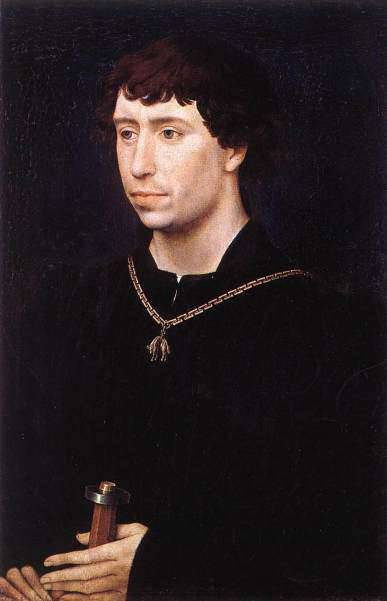
"Karl the Bold." Portrait of Rogier van der Weiden 1460. That is, he wrote it from nature, which is very important!
This is how a contemporary remembered that time, who witnessed the march of a Swiss column. “12 equestrian crossbowmen are riding in the head of the marching column, followed by two riders, several workers with axes, drummers and a company of soldiers armed with long peaks, numbering in excess of 500. Commanders go three in a row. The second squad consists of 200 arquebuisers and 200 halberdists, followed by a banner, accompanied by two ranks of state court. The main forces of the column consist of 400 excellently armed halberdists, 400 crossbowmen and a large number of pikemen. Two trumpeters close the main forces, followed by the captain of the entire detachment. The trailing squad includes pikemen and crossbowmen, led by a knight, who oversees order during the battle. A wagon train consisting of 30 carts with combat supplies and four bombarding ships follows. The whole marching column included about 4 000 people. ”
The Swiss army was quite numerous. As an example, the Swiss Union exhibited 70 to 000 people at the beginning of the Burgundy War. In addition, the Swiss were well prepared for combat. However, it should be noted the inhuman cruelty of the Swiss soldiers. During the hostilities, they did not take prisoners, but only captured them for public execution on the square during a national festival. This was done for a reason, but in order to suppress the enemy’s morale and demoralize him.
In comparison with the Swiss army, the army of Charles the Bold was not small and weak, but was backward in terms of military science. It was an ordinary medieval army, its main strength was knightly cavalry. The main division of the Burgundy army is the knightly “spear” of which the company consisted, which later became the organizational and tactical unit. The Duke of Burgundy in the 1471 year, using the innovation of the French army, organized the ordonance companies (or troops, in which the recruitment was by decree-ordonance). The same troops in peacetime did not disband. The talent of the duke as a military organizer was unsurpassed: thanks to him, the company, as a structure in the military unit, became more organized and perfect.
Karl Bold introduced such a structure as a division into 10 “copies” of 10 people, and then the company began to include 25 “copies”, which were divided into 4 “squadron” of six “copies” each; 25 th "spear" was considered "personal spear" for the company commander. The “spear” consisted of eight warriors: a gendarme — a knight, a “veil” (armed with a lance with an infantryman's hook), page, crossbowman, three horse archers, coolevriner (arrow from a cule gun). Each company was supposed to have its own banner of a strictly defined color with its number on the cloth.
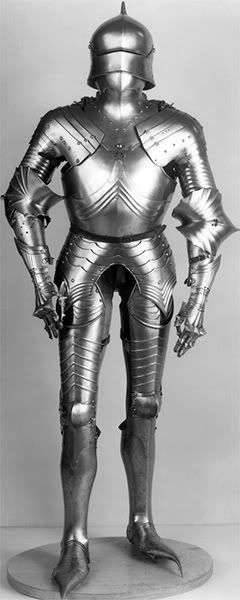
The typical knight of the ordnance company 1475 - 1485. Wallace Collection, London.
When building for combat order, the ordonance company lined up in four lines: first the knights, then the “kutil'e,” the horse and riflemen marched third and fourth. Knights were the main force of the company. Horse riflemen and "veil" served as a cover and protection for the knight. Karl Brave streamlined life in the army, regularly paid salaries to soldiers, ensured uninterrupted supply of food, in addition, provided and leave. But warriors required strict adherence to military discipline.
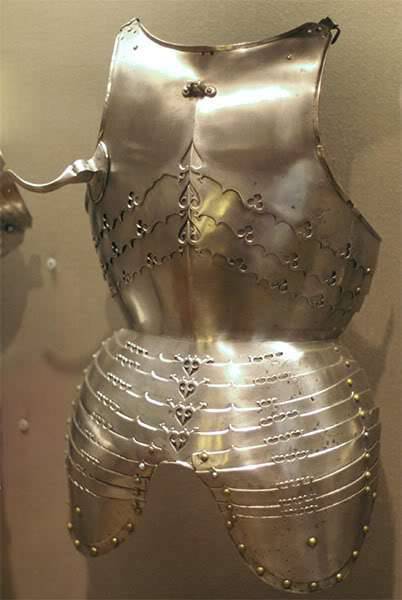
Breastplate of a knight of the ordonance company with a characteristic spear hook - focus. The presence of the armor is most often determined by the presence of the armor. There is - combat or tournament for a spear match, but a tournament must have a reinforcement on the left (grangard) and a corresponding helmet. If there is no wrestling, then this is, as a rule, ceremonial armor, or for a foot bout, but then they should have an appropriate “skirt”. Philadelphia Museum of Art. Philadelphia, PA.
The warlord also took care of the “body feast” for the servicemen: no more than 30 women were allowed to be present in each company (and therefore follow the campaign). The condition was tough: a woman cannot belong to only one warrior. In addition to the division into "spears", the Duke of Burgundy introduced differences in the types of troops, as required by the tactics of warfare. Special regulations were laid down, which contained certain rules for conducting military maneuvers (which in itself was nonsense!). The tasks were set quite specific: heavy riders with spears at the ready should learn to go on the attack in dense formation, to be able to separate and reassemble into combat units. Horse archers were trained in correct dismounting from a horse, accurate archery and, moreover, the ability to fight together with pikemen.
Unconditional obedience to the "statute" of military service and training became the very solid foundation, which then became the canons of the regular army. So it happened that the ordanance companies from the army of Charles the Bold became the basis of the regular army in Western Europe. From the very beginning of the war, the obvious superiority of the Swiss army over the Burgundy became noticeable. October 1474 of the year turned out to be fatal for Karl: the Swiss, along with the militia from the Alsatian allied cities, began a military campaign against the duke, entered into his possession. In the very first battle of Gericure, the Burgundians suffered a crushing defeat.
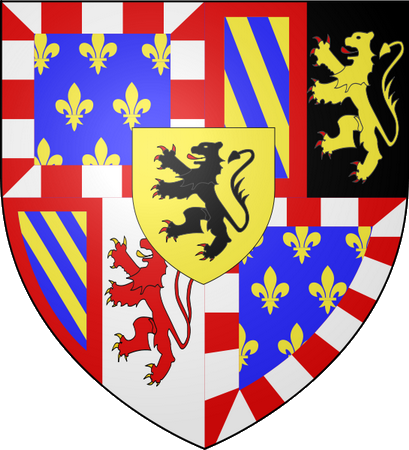
The coat of arms of the Duke Charles of Burgundy (1433 - 1477), Count de Charolais.
Throughout the following year, the Swiss Union also acted vigorously and decisively, continuing to capture all large territories. Karl tried in vain to regain the lost positions, failure after failure pursued him. It all ended in 1476, March 2, with the loss of Lorraine at the Granson Battle and the next rout.
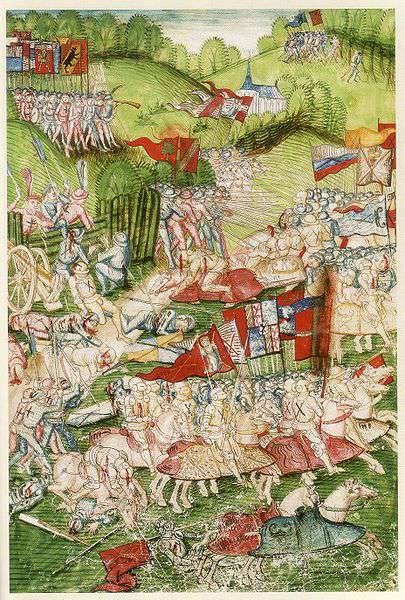
Battle of Murten 1476 Bern, City Library.
The summer of the same year brought new misfortune - the defeat of the troops at Murten. The situation became hopeless, but the duke remained cool. Organizational talent once again did not disappoint the duke. Gathering together all that remained of the army, and pulling up reinforcements, he besieged the city of Nancy. Bailing out the inhabitants of the besieged city immediately advanced twenty thousandth army of the Duke of Lorraine Rene, which consisted of the French, Austrians, Alsatians, Lothians and Swiss. The main striking force of this multinational army was the Swiss infantry, for which the Duke of Lorraine laid out a very large sum. The Duke of Burgundy was not going to give up Nancy, although due to the beginning of the famine in the besieged city, the situation became more and more tragic, and it went to the surrender of the city.
There was only one way out: start the battle, and it happened in January 1477, 5. The army of Charles the Bold numbered about 14 000 people, of whom 4 000 soldiers were left in the rear to prevent possible attacks from besieged Nancy. Karl Smely planned to replace the infantry infantry with a large number of artillery and at least a large number of handguns. Choosing a place to fight, Karl ordered the infantry to gain a foothold between the river Merta and the forest, the front to the south, leaving a narrow passage. The cavalry took place on the right and left sides of the infantry. Rear infantry covered fast stream. Karl’s plan was for the intensive fire of artillery and riflemen to break the ranks of the enemy’s infantry, thereby stopping his advance, and then, after attacking the knights, to drop it. Karl Brave, unfortunately, miscalculated about the cover from the rear. The Allies formed three columns, of which the rearguard was showing false activity in the center. Meanwhile, the main forces in two columns on the left and on the right side took in pincers both flank of the Burgundian army.
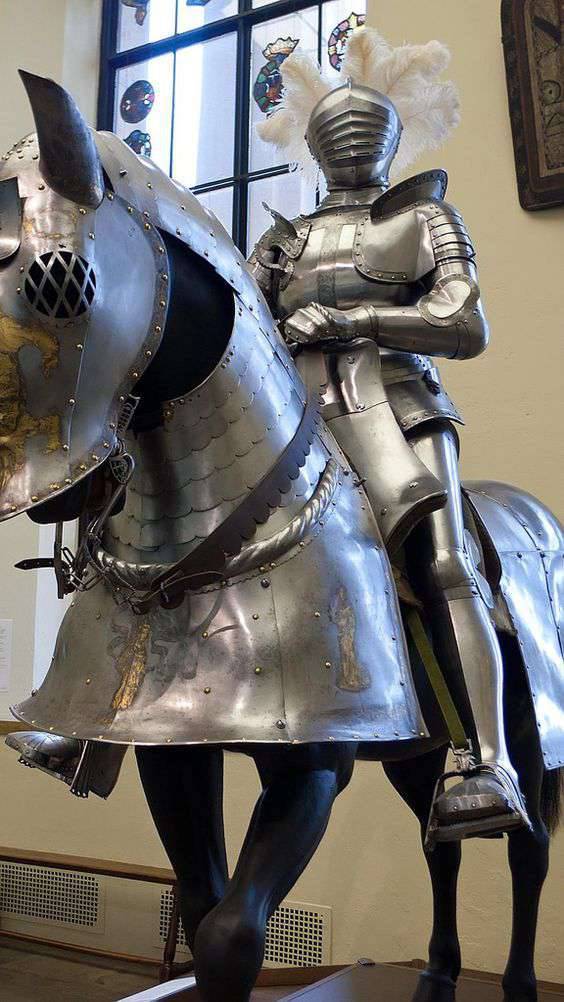
Duke Ulrich von Wurtenberg 1507 Field Armor. Philadelphia Museum of Art. Philadelphia, PA.
A strong snowstorm, played out that day, he was only on hand. Climbing through a dense forest and moving along the icy water of the stream, the Swiss were very exhausted, but it was worth it: the road was cut significantly, and the troops of Rene Lorraine reached the flank of the Burgundians.
The decisive attack undertaken by the Burgundian knights was initially successful, but the Swiss infantry entered into the business and pushed the knights far back. The Burgundians attempted to bring artillery into battle, but the attempt failed. The bombers who fired in poor visibility conditions failed to break the dense ranks of the Swiss. The main force of the Allies, who moved the column forward, swept away the Burgundians. An equally strong avant-garde column approached them from the other side. Going close to the bank of the river, it was inaccessible to the Burgundian guns. The Burgundians got into ticks and did not have the opportunity to repulse the superior forces of the infantry, which led to the shameful flight and their complete defeat. Most of the Burgundian troops were slaughtered, and Charles the Bold himself died. According to legend, trying to cross the stream, the wounded duke fell from his horse and ... froze. His corpse, disfigured by wounds inflicted, was identified only by a smart coat. It is said that part of his body was eaten by wolves. Duke René II ordered the remains of Charles the Bold to rest in the church of Saint-Georges there in Nancy. Much later, the coffin was transported to Bruges in the Church of Our Lady.
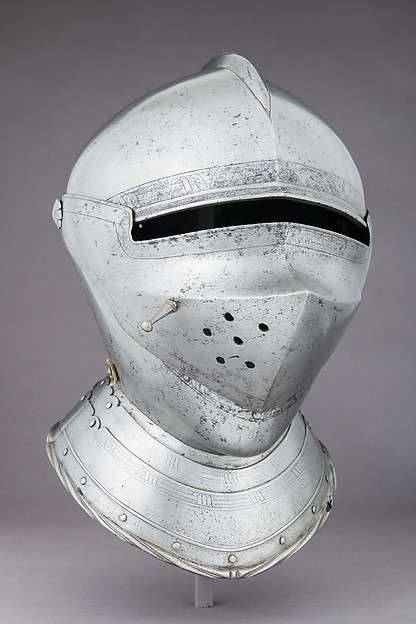
Arme 1500 Italy. Weight 3350 Metropolitan Museum, New York.
The battle of Nancy had a very serious political significance. The long feud of the French kings and the dukes of Burgundy, who really did not want to unite the French lands and, consequently, increase the power of the already united France, was completed. After the announcement of the death of Charles the Bold, part of the land of Louis XI annexed it to his lands. At the same time, he, with the help of others, took revenge on Karl for his humiliation and actual captivity during the uprising in the city of Liege (the events described quite well in the novel Quentin Dorward). The rights of Charles’s daughter, Mary of Burgundy, were infringed upon. The main achievement of this war was the acquisition of the Duchy of Burgundy and some parts of Picardy.
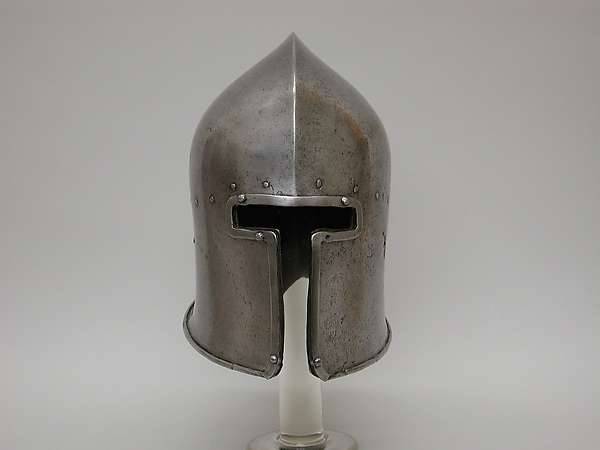
Barbute 1460. Weight 3285. Metropolitan Museum, New York.
It seems that the directors of the film “The Adventures of Quentin Dorward - the Arrow of the Royal Guard” made Quentin Dorward a good helmet - a real barbute! But ... why did they stick it with thorns? There are no such thorns on any extant Barbuda! Although in other scenes and armor, and weapons are quite realistic. Oh, this is our movie ...
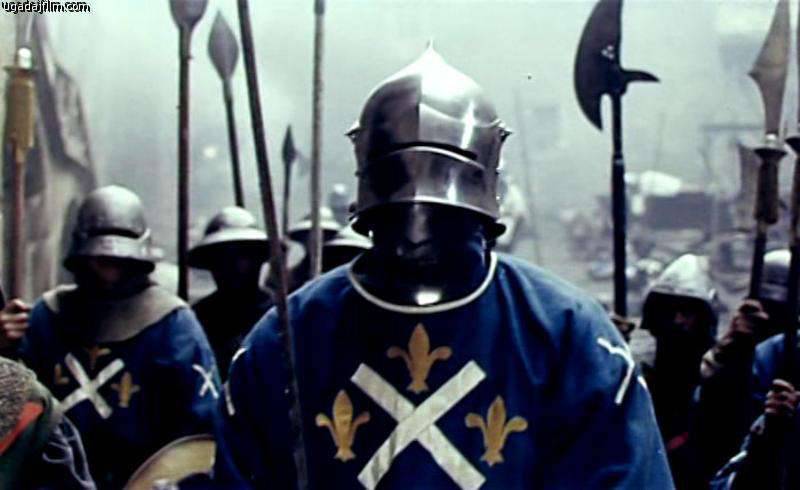
The warriors of Louis XI from the movie "The Adventures of Quantin Dorward - the Arrow of the Royal Guard" - a completely realistic picture.
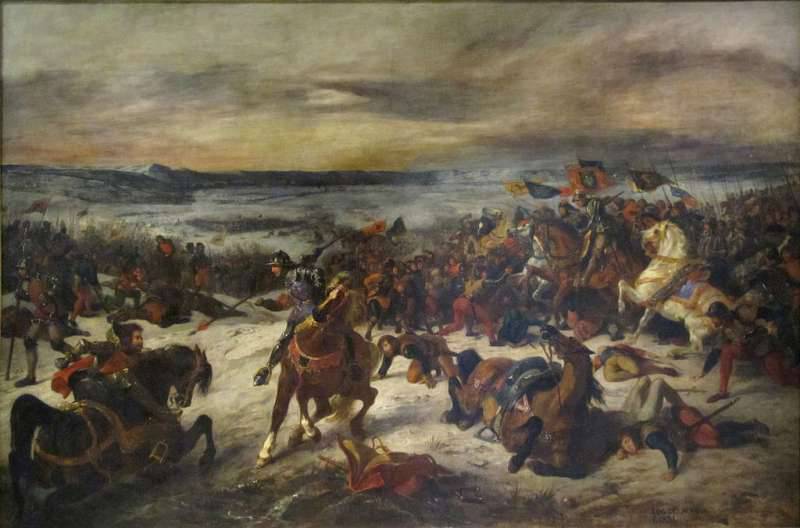
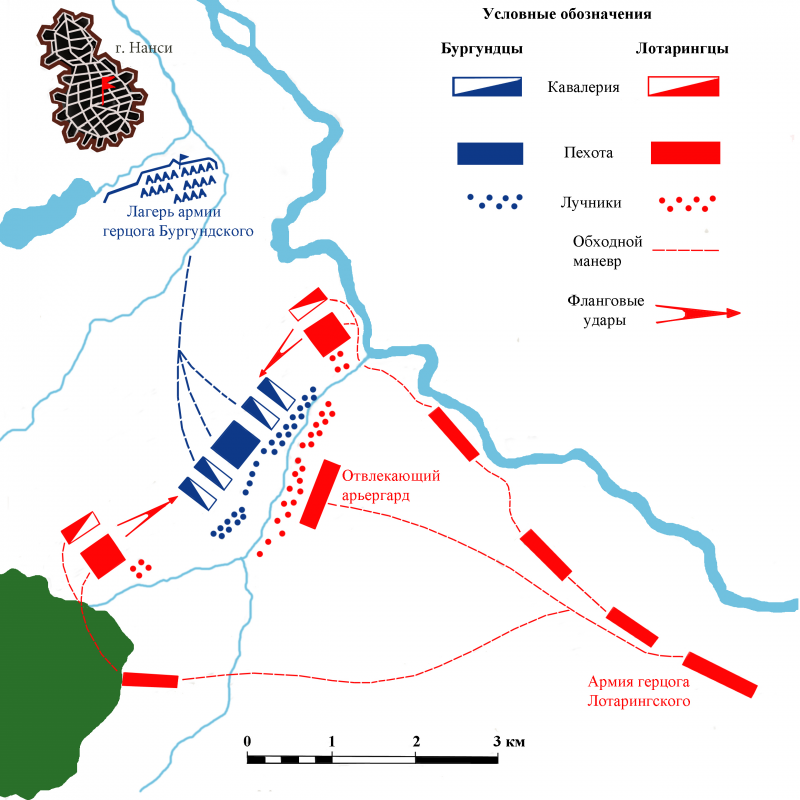
Information